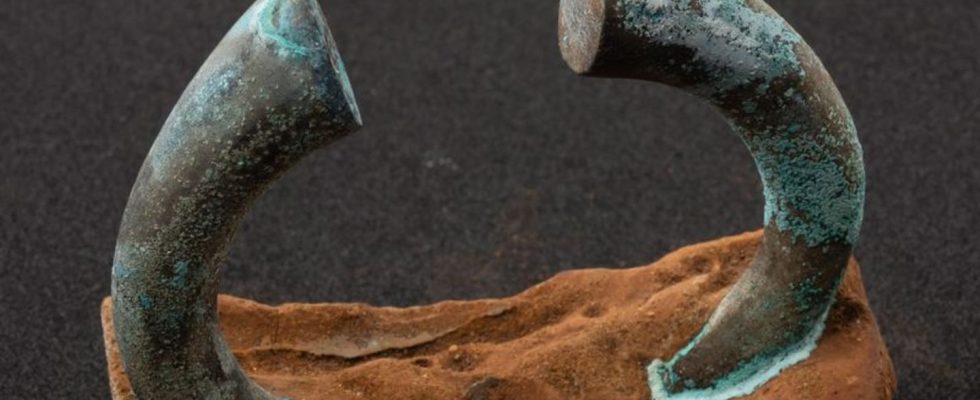cultural world
Material for many Benin bronzes comes from the Rhineland
A manilla concreted to part of a Flemish trader’s pot excavated by the Sociedad de Ciencias Aranzadi off Getaria, Basque Country, northern Spain. photo
© Ana Maria Benito-Dominguez/dpa
Some of the Benin bronzes from German museums have been returned. But now it is clear where their material comes from.
The material for many Benin bronzes comes from the Rhineland between Cologne and Aachen. This has been revealed by a study of lead isotopes in manillas, brass bangles, many of which were formerly melted down to make the Benin bronzes.
A contract between the German merchant family Fugger and the Portuguese king from 1548 for the delivery of manillas makes the analysis results plausible. The study by a research group led by Tobias Skowronek from the Technical University Georg Agricola in Bochum has been published in the specialist journal “PLOS ONE”.
The brass used was therefore produced in the Rhineland. “The Rhenish manillas were then transported more than 6,300 kilometers to Benin,” said Skowronek, according to the journal.
It was previously known that the very uniform lead isotope ratios in many of the Benin bronzes indicate a main source of material. The use of manillas, which were common currency in West Africa, for metal works of art from the Kingdom of Benin was also clarified.
That was the result of the investigations
For the investigation with a special mass spectrometry, the scientists had 67 manillas, which were dated to the 16th to 19th centuries, from five shipwrecks. The wrecks lay in African, European and American waters of the Atlantic. Other manillas came from Sweden, Ghana and Sierra Leone.
Skowronek and colleagues investigated lead isotope ratios on the one hand and the proportion of trace elements such as antimony, nickel, arsenic and iron on the other. Despite the designation “Benin bronzes”, most of the ancient works of art are made of brass, which mainly contains copper and zinc, but often also contains lead, tin and other elements.
The investigation showed that the zinc in the brass for the older manillas came mainly from the Rhineland. The different proportions of trace elements indicate that the copper used came from different sources, such as Mansfeld am Harz (Saxony-Anhalt), Banská Bystrica in Slovakia and possibly Scandinavia.
Since manillas played no role in European trade, manillas were produced in Europe almost exclusively for trade with Africa. From the 15th century onwards, it was mainly the Portuguese who traded with West African peoples, later other colonial powers joined them.
Debate on return to Nigeria
According to historical sources, African traders were very picky about the quality of the manillas. The fact that they preferred brass from the Rhineland could have been due to the relatively high lead content (up to 14 percent by weight). “Lead in brass results in an easy-flowing alloy and reduces porosity, making the alloy more suitable for casting,” the study authors write. For statistical reasons, Skowronek considers it very likely that the Benin bronzes in German collections also contain brass from the Rhineland.
Stefan Simon, Director of the Rathgen Research Laboratory at the Berlin State Museums, is very impressed with the study. It is a big step towards clarifying how the raw material got to Benin. It was particularly important for his laboratory to be able to identify counterfeits based on the material composition. Because after the sensational discovery of the Benin bronzes by the British in 1897, imitations repeatedly found their way onto the art market. Age determination was also important.
Lars-Christian Koch, director of the Ethnological Museum of the Berlin State Museums, assumes that the findings from the study will not change the debate about the return of the Benin bronzes to Nigeria very much. There had already been criticism of the return from some quarters, partly because the manillas were also used in the slave trade.
“It is important for us that we pursue new research approaches together with our partners in Nigeria,” says Koch. Because even scientific analyzes are dependent on ethnological and other humanities findings as well as on historical sources and traditions for interpretation.

